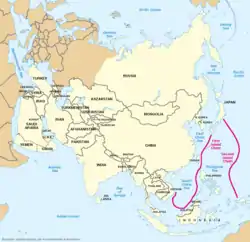Island Chain Strategy
The Island Chain Strategy is a strategy first mentioned by American foreign policy commentator John Foster Dulles in 1951 during the Korean War.[1] It suggests surrounding the Soviet Union and China by sea.[2] The island chain concept did not become a major theme in American policy, but it has become a major fixation of both American and Chinese analysts to this day. For the U.S. the island chain strategy is a big part of the military of the United States's force projection in the Eastern part of Asia. For Chinese, the concept is used as part of their fears of encirclement by American forces. For both sides, the island chain strategy emphasizes the geographical and strategic importance of Taiwan.[3]

First Island Chain
The definition of the First Island Chain begins at the Kuril Islands, and finishes towards Borneo and the northern portion of the Philippines. It is the first chain to block socialist countries aligned with the USSR, and after Soviet Russia is dealt with the chain would then turn its focus on China. The key part of the first chain would be Taiwan.
Because the island chain is built up of a series of landmasses, it is also called the "unsinkable aircraft carrier", especially in reference to Taiwan.
Second Island Chain
The Second Island Chain can refer to two different interpretations, but the version most commonly used refers to the island chain which is formed by the Bonin Islands and Volcano Islands of Japan, in addition to Mariana Islands, most notably Guam, which is United States territory.[1]
As it is located within the middle portion of the Pacific Ocean, it acts as a second strategic defense line for the United States.[1]
Third Island Chain
The Third Island Chain is the final part of the strategy. Its island chain begins at the Aleutian Islands, and runs through the central Pacific to Oceania. The Hawaiian Islands are included in this chain.[1]
Fourth and fifth island chains
The Asia Maritime Transparency Initiative said that a fourth and fifth island chains should be added to an overall understanding Chinese maritime strategy. Whereas the first three island chains are in the Pacific Ocean, these two new ones are in the Indian Ocean and this would reflect the growing Chinese interests in the Indian Ocean. The fourth island chain would include places like Gwadar, Hambantota and Diego Garcia while the fifth island Chain would originate from China’s base at Doraleh, Djibouti,.[1]
Target and events
The primary target of the doctrine was the USSR; however, additional targets also included the People's Republic of China, Vietnam, and North Korea. After the USSR collapsed in 1991, China soon became the major target of the doctrine.
References
- "CHINA'S REACH HAS GROWN; SO SHOULD THE ISLAND CHAINS". ASIA MARITIME TRANSPARENCY INITIATIVE. Center for Strategic and International Studies. Retrieved 12 November 2020.
- Umetsu, Hiroyuki (1996-06-01). "Communist China's entry into the Korean hostilities and a U.S. proposal for a collective security arrangement in the Pacific offshore island chain". Journal of Northeast Asian Studies. 15 (2): 98–118. doi:10.1007/BF03028144 (inactive 2021-01-15). ISSN 1874-6284.CS1 maint: DOI inactive as of January 2021 (link)
- Yoshihara, Toshi (July 2012). "China's Vision of Its Seascape: The First Island Chain and Chinese Seapower: China's Vision of Its Seascape". Asian Politics & Policy. 4 (3): 293–314. doi:10.1111/j.1943-0787.2012.01349.x.